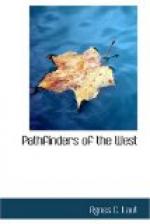Locking the sally-port, the company—as the Jesuit father records—“shook the dust of Onondaga from their feet,” launched out on the swift-flowing, dark river and escaped “as the children of Israel escaped by night from the land of Egypt.” They had not gone far through the darkness before the roar of waters told them of a cataract ahead. They were four hours carrying baggage and boats over this portage. Sleet beat upon their backs. The rocks were slippery with glazed ice; and through the rotten, half-thawed snow, the men sank to mid-waist. Navigation became worse on Lake Ontario; for the wind tossed the lake like a sea, and ice had whirled against the St. Lawrence in a jam. On the St. Lawrence, they had to wait for the current to carry the ice out. At places they cut a passage through the honeycombed ice with their hatchets, and again they were compelled to portage over the ice. The water was so high that the rapids were safely ridden by all the boats but one, which was shipwrecked, and three of the men were drowned.
They had left Onondaga on the 20th of March, 1658. On the evening of April 3d they came to Montreal, where they learned that New France had all winter suffered intolerable insolence from the Iroquois, lest punishment of the hostiles should endanger the French at Onondaga. The fleeing colonists waited twelve days at Montreal for the ice to clear, and were again held back by a jam at Three Rivers; but on April 23 they moored safely under the heights of Quebec.
Coureurs from Onondaga brought word that the Mohawks had been deceived by the pig and the ringing bell and the effigies for more than a week. Crowing came from the chicken yard, dogs bayed in their kennels, and when a Mohawk pulled the bell at the gate, he could hear the sentry’s measured march. At the end of seven days not a white man had come from the fort. At first the Mohawks had thought the “black robes” were at prayers; but now suspicions of trickery flashed on the Iroquois. Warriors climbed the palisades and found the fort empty. Two hundred Mohawks set out in pursuit; but the bad weather held them back. And that was the way Radisson saved Onondaga.[9]
[1] The uncle, Pierre Esprit Radisson, is the one with whom careless writers have confused the young hero, owing to identity of name. Madeline Henault has been described as the explorer’s first wife, notwithstanding genealogical impossibilities which make the explorer’s daughter thirty-six years old before he was seventeen. Even the infallible Tanguay trips on Radisson’s genealogy. I have before me the complete record of the family taken from the parish registers of Three Rivers and Quebec, by the indefatigable Mr. Sulte, whose explanation of the case is this: that Radisson’s mother, Madeline Henault, first married Sebastien Hayet, of St. Malo, to whom was born Marguerite about 1630; that her second husband was Pierre Esprit Radisson of Paris, to whom were born our hero and the sisters Francoise and Elizabeth.




